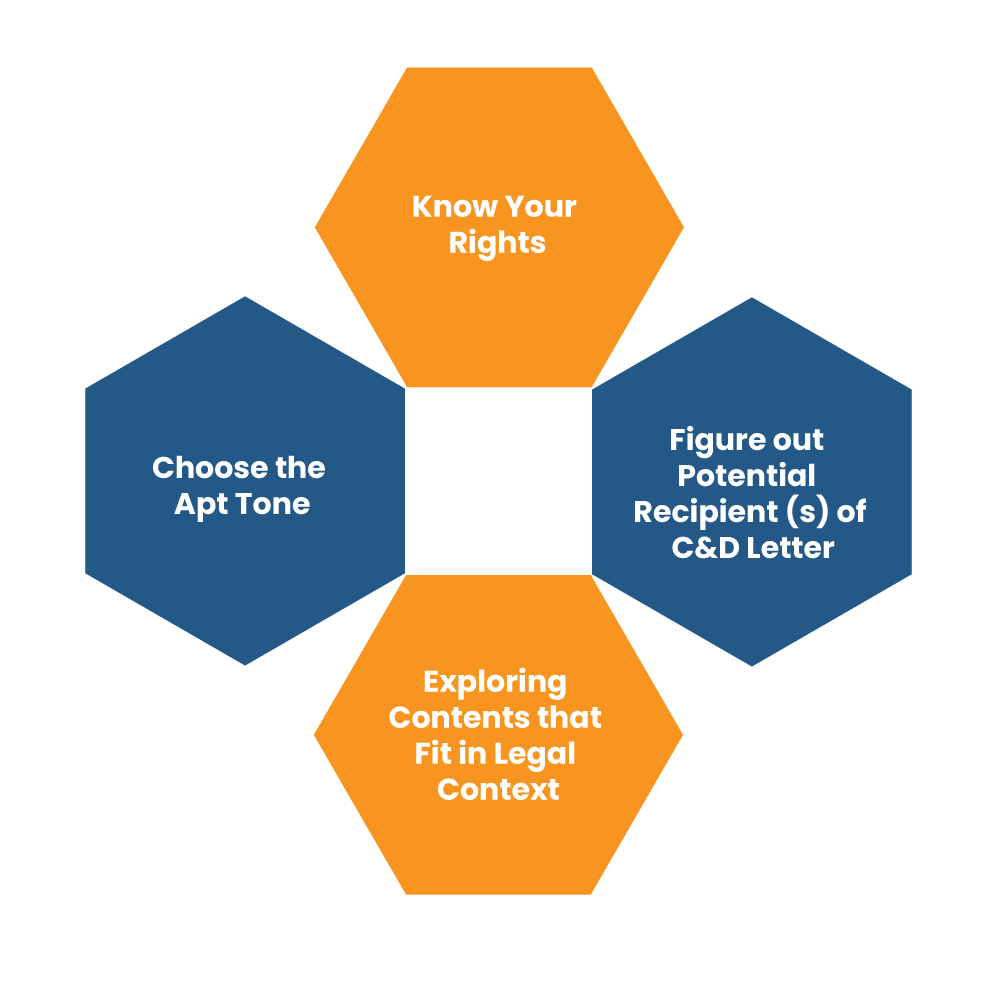A cease and desist letter refers to a notification sent to the person or a business entity to deter an action of infringing the Intellectual Property Rights. Fundamentally, cease and desist notices are sent as a warning letter to the defaulters or infringers before initiating the legal proceedings.
Sending Cease and Desist Letters to the Infringers
Brand owners with registered trademarks need to keep an eye on rivals’ activity to ensure full-fledged protection for their trademark. The unlawful use or counterfeiting of trademarks by outsiders can be intentional or unintentional.
In some situations, counterfeiting could lead to infringement of copyrights as well. Thus, it is imperative to leverage C&D letters promptly after encountering such a situation.
Read our article:Different IP Rights in India: A Complete Checklist
Answering to Cease and Desist Letters
If you receive the said letter, it is advisable to send a strong response without incurring any delay. In the response, each point enclosed in the letter must be responded to with paramount clarity. Additionally, further affirmations (denials, submissions, comments) should be added as well. This will be beneficial in case of subsequent legal proceedings if the requirement arises.
Key Deliberations for Cease and Desist Letters
There are few key deliberations for cease and desist letters, which are as follows:-
Encompasses all the Relevant points in the C&D letters
Factually, cease and desist letter is deemed as a warning letter. It is immensely imperative to ensure that the content in such letters encompasses all the relevant points, considering the pleading’s basic rule. It indicates that the concerns that came to light at the stage of such letters should be extensive enough to cover future claims via legal proceedings if required. This would deter the third party from taking defense that the claims raised were not part of the original cease and desist letter.
Know the Legal Enforceability of your Rights
In some cases, such letters can lead to specific risks, such as providing infringers with an unintentional opportunity to sue the owner itself. It may happen if they have strong reason to believe that the possible infringement is far from reality or the owner does not possess a valid trademark. In light of this, the defaulter may continue infringing the IP and overlook the notice, forcing the owner to leverage stricter legal proceedings to safeguard IP.
Embrace Sensible and Legally Fit Drafting
Thus, before sending such letters, it is imperative to identify the extent of use, i.e., infringement period, and then decide whether sending a notice is a viable option or not. In some jurisdictions, a cease and desist letter do not possess legal enforceability. However, it is still deemed the most viable way to prevent an infringer from infringing the IPRs. A formal demand to cease infringing activities is often overlooked by infringers, but the rightly drafted cease and desist letter can prevent them from doing so.
Cease and Desist Letter Response
It is important to respond to a cease and desist letter on time from a legal purview. It is better to hire a trademark attorney to prepare a pinpoint response since such letters are subjected to plenty of legal implications. Based on the case, several grounds can be leveraged to curb allegations that seem unreasonable. The said grounds may include;
- Different target markets
- Different consumer behavior
- The dissimilarity between the brands
- Different target jurisdictions
Point to be Considered before Drafting Cease and Desist Letter
Below are some essential considerations that you must take into account before the drafting of C&D Letters.


Know Your Rights
First, you need to figure out what rights are accessible to you in such a case. For instance, suppose you possess a valid copyright registration for a sound recording, the cease and desist letter could enclose details such as registration number and sound recording title. Dealing with a registered IP can be less confusing because the scope of rights available to the sender of such letters is defined.
However, the same cannot be claimed for unregistered IPs such as unregistered songs or scenarios where the owner is asserting rights accessible under the license. The primary issue to avert in this context is asserting rights you don’t possess. The rights you own in the particular state may not be enforceable in other states.
Thus, considering the geographical limitation of rights is equally important. You have to draw a line of distinction between rights obtained through utilization and rights available under the license. Enhanced clarity on the rights will help you draft a C&D letter precisely and accurately.
Figure out who is the Potential Recipient (s) of the C&D Letter
The next thing you must do is to identify the Recipient (s) of the C&D letter. It would help if you were assured of their address or principle place of business because the last thing you do not want to send the notice to the wrong person.
Another vital consideration that you must take into account is the identification of indirect infringers. Keep in mind that indirect infringement is equally vicious as direct infringement. According to prevailing law, indirect infringement is classified into two following forms:
Contributory Infringement
Contributory infringement occurs when the person materially contributes to the conduct of the direct infringer.
Vicarious Infringement
A person can be liable for vicarious infringement if he/she posses definite control over the direct infringer and reap monetary benefit from the act of infringement
Exploring Contents that Fit in a Legal Context
The cease and desist letter must clearly reflect the notice’s intention, the manner in which the infringement has occurred, the timeline of infringement, and the proposed course of actions for the Recipient. The actions you identify must be thoroughly synced with your scope of rights to avert any legal disputes.
You must cautiously figure out a proposed course of action for the Recipient as it would help in preserving the credibility of the C&D letter. Avoid adding unreasonable or irrational demands that do not fit in the legal context.
Choose the Apt Tone
The tone is everything in a legal purview. If you opt to send a legal notice that embraces a threatening style, the Recipient might sue you if he/she has a reasonable understanding of litigation. Thus, it is advisable to stick around with a fair tone while drafting the essential points into the Cease and Desist Letter. This will help in keeping the possibility of the potential preemptive lawsuit as low as possible.
Conclusion
It is evident from the above information that the drafting of Cease and Desist Letter seeks reasonable apprehension of litigation and IPR law. Sending a legal notice may sound like a straightforward affair, but it is subjected to a lot of reasoning and legal connotations in reality.
Trademark owners generally send cease and desist letters as the most effective method to discourage trademark infringement in India[1]. The trademark lawyers find such letters as one of the amicable ways to settle disputes. Usually, such communication is sufficed to counteract inappropriate competition by deterring the infringer from counterfeiting, and in some cases, it helps in recovering losses from the infringer.
Read our article:A Complete Overview of International Rules in Indian IPR Law











